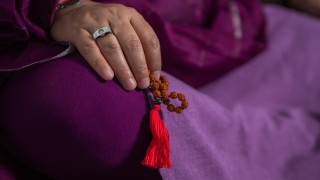
Mulabandha
Is mulabandha all about contraction? Is it only about the physical level?

![]() 3 minutes
3 minutes
Q: I am very well aware of the power of Mantras and Mudras in Yoga but somehow I do not feel confident in using them as tools in the classes I lead or in Yoga as Therapy. What should I do?
Response: Nothing. Simply wait! Breath is the mantra and awareness is the Mudra
Learning is a 3 step process. Simply because we have intellectually grasped an idea does not mean it has become a part of who we are. There are stages in the digestion of information. Honor the 3 stages.
What is the rush? Information goes in through the manas (sensory mind) and then has to marinate in the Buddhi (higher intellect) to become wisdom. Once you give it the gift of practice with dedication, intention and consistency it sprouts like a seed does. It slowly becomes a part of you and runs in your body like prana, breath and blood. It becomes you. Then comes the stage when each cell of your body conspires to share it effortlessly. That seamlessness is important when transmitting these practices in your classes, else they are simply crammed words, styles and techniques.
There are so many tools for YogaSadhna (practice) and Yoga Chikitsa (Therapy): Shat Kriyas, Apana Kriyas, Dinacharya, Asana, Pranayama, Mantra, Mudra, Bandhas, , Dharana, Yoga Nidra etc and every single tool is powerful and important as they recalibrate the doshas in a completely different way.
When we talk in terms of using a tool there are 3 things which are important to figure out:
a) Finding the most efficient tool for the specific condition and/or goal
b) Finding out which tool you have personally practiced and experienced most deeply
c) Discerning the readiness and capacity (physical, mental, energetic, emotional and spiritual) of the person concerned.
If you do not feel ready for Mantra and Mudra use breath awareness. Breath is the mantra and awareness is the Mudra
There are no short cuts in Yoga. You have to go step by step, these steps are not going to be given by someone outside. You will know based on your appetite and digestive power. Pay attention to where you are. There is no place for ego or shame in YogaSadhna. Walk on!
STAY IN TOUCH
Start your FREE subscription to Indu Arora's newsletter to get more on Yoga and Ayurveda here
Say hello on Instagram
Subscribe to my Youtube Channel.

Is mulabandha all about contraction? Is it only about the physical level?

Is there a right way to chant AUM? Is it OM or AUM or Om or oM?
There is more to Ganehsa than just being an elephant headed God.
Ganesha is symbolic of the 10 pranas within our body. He is the pranamaya kosha.